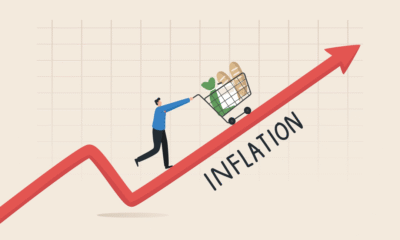Economics
Understanding the UK’s Cost-of-Living Crisis: Inflation and Its Impact on Households

Introduction to the Cost-of-Living Crisis
The cost-of-living crisis in the United Kingdom has emerged as a pressing concern for households across the nation. It is characterized by the increasing expenses associated with essential goods and services, coupled with stagnant or declining income levels. This phenomenon has evolved due to a confluence of factors, including rising inflation rates, supply chain disruptions, and changes in consumer behavior. As a result, many families are finding it increasingly challenging to maintain their standard of living.
Inflation, specifically, plays a critical role in the current cost-of-living crisis. Defined as the rate at which the general level of prices for goods and services rises, inflation erodes purchasing power, meaning that households can buy less with the same amount of money. This has been particularly acute in the UK, where inflation rates have surged in recent years, driven by factors such as higher energy costs and post-pandemic economic recovery challenges. For example, recent statistics reveal that the inflation rate has consistently outpaced wage growth, leading to a significant squeeze on disposable income for many families.
Furthermore, the impact of global events, such as the COVID-19 pandemic and geopolitical tensions, has exacerbated the situation. Supply chain issues have resulted in shortages of key items, further pushing up prices and compounding the difficulties faced by consumers. The cumulative effect of these factors has led to a situation where basic necessities, including food, housing, and transportation, have become increasingly unaffordable for a considerable proportion of the population. It is essential to understand the scope and dynamics of this cost-of-living crisis as it directly influences the quality of life for millions of individuals and families across the UK.
What is Inflation?
Inflation is an economic phenomenon characterized by the general increase in prices of goods and services over time, leading to a decrease in purchasing power. In simpler terms, as inflation rises, every unit of currency buys fewer goods and services, directly impacting the cost of living for households. Understanding inflation is crucial, particularly in the context of the UK’s current economic landscape, where inflation rates have seen significant fluctuations.
Inflation can be categorized into several types, notably demand-pull and cost-push inflation. Demand-pull inflation occurs when the demand for goods and services exceeds their supply, often in a growing economy. This heightened demand enables producers to raise prices, resulting in increased inflation rates. Conversely, cost-push inflation arises when production costs increase, driving up prices for consumers. Factors contributing to cost-push inflation can include rising wages, higher raw material costs, or supply chain disruptions.
The UK’s inflation rates have exhibited notable trends, particularly influenced by global economic conditions. For instance, supply chain challenges exacerbated during the pandemic significantly impacted the prices of essential goods. Moreover, geopolitical issues can also play a pivotal role in shaping inflation trends. The recent increases in energy prices due to global tensions have further pressured the inflation rates in the UK, as households grapple with soaring utility bills and fuel costs.
As consumers navigate this complex landscape, it is vital to recognize how inflation affects individual purchasing decisions and long-term financial planning. The continuous rise in prices can lead to a gradual erosion of savings, highlighting the importance of understanding inflation for effective budgeting and maintaining financial stability. Consequently, grasping the concept of inflation and its implications is pivotal for both policymakers and households alike.
The Current State of Inflation in the UK
As of 2023, the United Kingdom is experiencing significant inflation, marking one of the most challenging economic periods in recent history. The most recent statistics indicate that the annual inflation rate has surged to approximately 6.4%, a notable increase from the previous year. This rise is indicative of the broader trend observed since mid-2021 when inflation rates began to steadily climb from the historical lows seen during the pandemic. A year-on-year comparison reveals a dramatic shift, highlighting the urgency of addressing the factors contributing to this inflationary pressure.
Several forces are at play, driving the inflationary landscape. Economic policies enacted in response to the COVID-19 pandemic aimed to stabilize the economy by injecting liquidity into the market. However, this expansionary monetary policy has inadvertently contributed to inflationary pressures. Coupled with this, global supply chain disruptions, exacerbated by geopolitical tensions and recent trade policies, have led to marked increases in the costs of goods and services.
Additionally, other post-pandemic effects, including wage growth and increased demand for services previously restricted during lockdowns, have further compounded the inflation scenario. The combination of these external and internal factors creates a complex environment, which necessitates a comprehensive approach to mitigate the impacts on households and businesses alike. Historical context reveals that while inflation can fluctuate, the current trajectory suggests a persistent challenge that requires careful consideration from policymakers to ensure stability and protect consumer purchasing power.
As we navigate through these turbulent economic waters, it is essential to monitor subsequent developments in inflation rates and the effectiveness of strategies designed to curb this rising tide. The financial implications for households throughout the UK remain a critical area of concern, with the potential to shape the future financial landscape of the nation.
Effects of Inflation on Household Budgets
Inflation has a significant impact on household budgets across the UK, resulting in increasing prices for essential goods and services. As inflation rises, consumers may find that their purchasing power is eroded, forcing families to reassess their financial priorities. Essential commodities such as food, energy, and transportation are often the first to feel the pressure of rising costs, creating immediate challenges for households trying to maintain their living standards.
For instance, the cost of groceries has surged as food prices climb, leading families to spend more to obtain the same quantity of basic items. Many households may find it increasingly difficult to budget for groceries, resulting in a shift towards cheaper, less nutritious options or even the compromise of skipping meals. This is particularly concerning, as it directly affects the health and well-being of household members, emphasizing the need for a delicate balance between budget adherence and nutritional value.
Similarly, energy costs have also seen considerable increases. Households are confronted with higher bills for gas and electricity, essential utilities that cannot be easily avoided. In response, many families are adopting energy-saving measures, such as reducing heating use in colder months or opting for energy-efficient appliances. Such adaptations, while helpful in mitigating costs, may not always align with comfort levels during extreme weather conditions, highlighting the trade-offs families are compelled to make.
Transportation expenses, too, are affected by rising inflation, as fuel prices escalate. Families may be forced to reconsider their commuting options, cutting down on travel or relying on public transport, which may not always be feasible or convenient. This adjustment to spending habits illustrates the broader shifts taking place in household finances as families strive to navigate the challenges presented by inflation.
Overall, the implications of rising inflation on household budgets are far-reaching and multifaceted. Families in the UK are adapting their spending patterns and making necessary compromises in order to manage their finances effectively in the face of these economic pressures.
Demographic Impact: Who is Most Affected?
The ongoing cost-of-living crisis in the UK has distinct impacts on various demographic groups, particularly highlighting how different factors like age, socioeconomic status, and geographic location can exacerbate the situation. Among the most vulnerable groups are low-income families, pensioners, and single-parent households. Since inflation affects essential goods and services, these groups often find themselves at a greater disadvantage, struggling to cope with rising costs.
Low-income families are particularly hit hard by the surge in prices for basic necessities. An increase in the cost of food, energy, and housing can consume a disproportionate share of their limited budgets. Families with children, especially those reliant on state support, often face difficult choices regarding expenditures, further accentuating their financial strain. This situation is compounded for single-parent households, where a single income may not suffice to manage escalating living costs, leading to increased reliance on community resources and support systems.
Pensioners also bear significant burdens due to the inflationary environment. Many retirees depend on fixed incomes, which can lead to a declining purchasing power as costs rise. The cost-of-living crisis is particularly acute for older adults, who may face higher healthcare expenses alongside general inflation. Moreover, seniors tend to spend a greater proportion of their income on essential services, further limiting their financial flexibility.
The geographical disparities also play a crucial role in defining the demographic impact of the crisis. For example, households residing in rural areas may encounter higher transportation and utility costs compared to those in urban settings, creating a distinct sets of challenges. This interplay of factors illustrates that the repercussions of inflation and the cost-of-living crisis are not experienced evenly across society. Recognizing these differences is essential for addressing the needs of the most affected demographics.
Government Response and Policy Measures
The UK government’s response to the ongoing cost-of-living crisis has involved a multifaceted approach aimed at addressing the financial pressures facing households. With inflation rates reaching levels not seen in decades, citizens have expressed significant concern about their ability to meet basic living expenses, prompting the government to initiate a series of policy measures. One of the primary initiatives includes the introduction of financial assistance programs designed to support vulnerable populations. These programs often provide direct cash payments or targeted subsidies to help low-income families bear the brunt of rising costs.
In addition to direct financial aid, the government has proposed reforms in various sectors, including energy pricing, housing, and taxation. For instance, measures to cap energy prices for consumers have been discussed, with the aim of ensuring that skyrocketing energy bills do not exacerbate the hardship faced by households. Furthermore, efforts to implement temporary tax relief for lower-income brackets are under consideration, which would relieve some of the financial burden caused by inflationary pressures.
However, the effectiveness of these measures remains a subject of debate among economists and the public. Some experts argue that while immediate relief is necessary, sustainable long-term solutions must address the underlying causes of inflation. Public reaction to these initiatives has been mixed; many welcome the government’s recognition of the problem but express concerns that the responses may not be sufficient or timely enough to alleviate the ongoing strain on most households.
As discussions continue around future policy implications, it is crucial for the government to remain responsive to the evolving economic landscape and the needs of its citizens in order to effectively combat the challenges posed by the cost-of-living crisis.
Long-term Implications of High Inflation
The sustained high inflation in the UK carries significant long-term implications for both the economy and society. One primary concern is the potential stagnation of economic growth. As inflation rises, consumer purchasing power erodes, leading to decreased spending on goods and services. This decline can hinder overall economic activity, as businesses may experience lower revenues and, consequently, be less inclined to invest in expansion or innovation—factors essential for fostering growth.
Furthermore, prolonged high inflation often results in notable shifts in consumer behavior. Households may adjust their purchasing habits, prioritizing essential items over discretionary spending. This transformation in expenditure can lead to long-term changes in market dynamics as businesses adapt to the evolving demands of consumers. Industries linked to non-essential goods may struggle, leading to business closures and job losses, further exacerbating the economic impact.
The housing market is another sector likely to experience significant shifts due to high inflation. As living costs rise, potential buyers may find themselves priced out of the market, impacting demand and, subsequently, housing prices. This scenario could lead to decreased construction activity and infrastructure investment, hindering economic recovery and contributing to a prolonged housing crisis. Additionally, renters may face heightened financial pressures, prompting a potential rise in rental rates as landlords look to maintain profit margins amid inflationary pressures.
In response to these challenges, policymakers might explore shifts in strategies toward wage growth or taxation to mitigate the adverse effects of inflation. Enhanced focus on increasing wages could help maintain consumer purchasing power, while adjustments in tax policy might help alleviate pressures on households. However, implementing these changes would require careful consideration of their broader economic implications, highlighting the complexity of managing long-term inflation. Addressing the multi-faceted impact of high inflation is essential for paving a sustainable path for the UK’s economic future.
Coping Strategies for Households
The current cost-of-living crisis in the UK presents significant challenges for many households. Rising inflation rates and increasing prices of essential goods have compelled individuals and families to adopt effective coping strategies. A primary approach for navigating these tough economic times is budgeting. By meticulously tracking income and expenses, households can identify areas where savings can be made. Utilizing budgeting tools, such as apps or spreadsheets, permits a clear overview of financial habits, enabling better management of funds.
In conjunction with a robust budgeting plan, smart shopping practices can further alleviate the financial burden on families. For instance, consumers should consider purchasing generic or store-brand products, which often offer the same quality at a lower price compared to branded items. Additionally, utilizing cash-back and discount apps can yield further savings when shopping. Planning meals for the week can contribute to reduced grocery bills, as it allows for purchase of ingredients in bulk and minimizes food waste. Importantly, households should seize opportunities to join loyalty programs offered by supermarkets and retailers, which often come with exclusive discounts and offers.
Furthermore, it is advisable to stay informed on available resources and community initiatives aimed at supporting those struggling with rising costs. Numerous charities and local organizations in the UK provide assistance, whether it’s through food banks, financial counseling, or workshops on financial literacy. Engaging with community support can not only alleviate immediate financial pressures but also empower households with knowledge and tools for sustainable budgeting.
Adopting these strategies can enable households to better manage their finances amidst the ongoing cost-of-living crisis, providing a sense of control and ability to navigate these challenging times effectively.
Conclusion and Future Outlook
The UK’s cost-of-living crisis has been significantly shaped by rising inflation rates, which have directly influenced household budgets across the nation. Key highlights of this issue reveal that inflation has various repercussions, including increased prices for essential goods and services, which strain the financial stability of families. Households have had to adapt to these economic changes, often resulting in difficult decisions regarding expenditure and savings.
Looking ahead, the trajectory of inflation remains uncertain. Factors such as global supply chain disruptions, energy prices, and economic policies will play a crucial role in determining future inflation rates. The predicted patterns suggest that inflation may stabilize in the coming months, yet fluctuations could still occur due to external economic pressures. Households are encouraged to monitor these changes closely, as they will impact disposable income, purchasing power, and overall financial health.
As we navigate through this challenging landscape, it is vital for readers to remain informed about the evolving economic environment. Staying updated on inflation trends and potential government interventions will be crucial for making informed financial decisions. Additionally, individuals might consider strategies to enhance their financial readiness, such as budgeting, seeking financial advice, or exploring alternative income sources. By understanding the dynamics of inflation and its implications on household finances, individuals can better prepare for potential fluctuations and make more informed choices in their personal finance management.
In conclusion, comprehending the cost-of-living crisis and its connection to inflation is essential for all households. By staying vigilant and proactive, families can navigate these economic challenges more effectively and work towards achieving financial stability amid ongoing changes.
Finance & Investment
Trade Surveillance in Banking: Lessons from JPMorgan’s $348 Million Fine

Trade surveillance is a critical compliance function in banking and financial services that ensures the integrity of market activities and adherence to regulatory requirements. Effective trade monitoring helps prevent market abuses such as insider trading, front-running, and manipulation, protecting both investors and the broader financial system. Recently, JPMorgan Chase faced a substantial $348 million fine imposed by the Federal Reserve and the Office of the Comptroller of the Currency (OCC) due to inadequate trade surveillance controls. This high-profile penalty serves as a stark reminder to banks worldwide about the vital need for robust monitoring systems. Trade surveillance involves collecting and analyzing massive volumes of trading data in real time to identify suspicious behaviors or patterns that may indicate misconduct. As markets become more complex and trading volumes grow exponentially, financial institutions must invest heavily in surveillance technologies and governance frameworks to meet evolving regulatory expectations and safeguard their reputations.
The JPMorgan Case: What Went Wrong?
JPMorgan Chase’s penalty arose from several shortcomings in its trade surveillance program. Regulators found that the bank’s monitoring systems failed to adequately cover all trading venues and did not effectively analyze the full range of data needed to detect potential misconduct. Gaps in oversight allowed certain trading activities to go unchecked, increasing the risk of market abuses. Additionally, the bank’s controls were insufficient in preventing or identifying misconduct promptly, which is crucial for timely investigation and remediation. These deficiencies pointed to weaknesses in both technology infrastructure and internal governance. The case highlighted the consequences of inadequate surveillance, not only in terms of financial penalties but also reputational damage and potential loss of client trust. For financial institutions, the lesson is clear: trade surveillance cannot be an afterthought but must be a comprehensive, continuously updated program integral to daily operations.
Best Practices for Effective Trade Surveillance Systems
To avoid costly penalties and operational risks, banks need to implement trade surveillance systems that are robust, scalable, and adaptive. Best practices include integrating advanced analytics capable of processing large data sets across multiple trading platforms in real time. Machine learning and artificial intelligence technologies are increasingly being used to improve anomaly detection, reduce false positives, and provide compliance teams with actionable insights. Comprehensive surveillance programs also require strong governance frameworks that ensure clear roles, responsibilities, and accountability within the institution. Regular audits and continuous improvement cycles help identify gaps and adapt to new market practices or regulatory changes. Employee training and cultivating a compliance-oriented culture are equally important to ensure that staff understand surveillance requirements and actively support adherence. Transparency in reporting and effective communication with regulators can further enhance a bank’s ability to manage compliance risks proactively.
Technology’s Role in Enhancing Trade Surveillance
The complexity of modern financial markets demands that trade surveillance leverages cutting-edge technology solutions. Automated systems can monitor millions of trades, cross-referencing data from various sources such as order books, messaging systems, and market data feeds. AI-powered algorithms identify suspicious patterns that human monitors might miss and prioritize alerts for compliance teams to investigate. These technologies not only improve detection speed but also help reduce the burden of manual reviews, allowing staff to focus on high-risk cases. Additionally, cloud computing and big data architectures enable scalable storage and processing power essential for handling the volume and velocity of trade data. Implementing these technological advancements positions banks to meet stringent regulatory standards while maintaining operational efficiency and competitive advantage.
Strategic Takeaways for Banks and Financial Institutions
The JPMorgan fine underscores that trade surveillance is a critical area where banks cannot afford complacency. Financial institutions must treat compliance as a strategic priority, allocating sufficient resources to technology, people, and processes. Proactive investment in surveillance infrastructure not only reduces the risk of regulatory penalties but also enhances trust among clients and investors. Moreover, comprehensive trade monitoring helps detect internal control weaknesses and potential operational risks early, preventing larger issues. Institutions should conduct regular risk assessments to identify vulnerabilities and tailor surveillance parameters accordingly. Collaboration with regulators and industry groups can provide insights into emerging threats and best practices. Ultimately, integrating trade surveillance into the core of banking operations fosters a culture of integrity and resilience that benefits the institution and the financial markets as a whole.
Conclusion: Compliance as a Competitive Advantage
In conclusion, the JPMorgan Chase $348 million fine serves as a powerful cautionary tale for the banking sector, emphasizing the critical importance of effective trade surveillance. As financial markets evolve and regulatory scrutiny intensifies, banks must invest in sophisticated monitoring systems supported by advanced analytics and a strong compliance culture. Trade surveillance is not merely a regulatory obligation but a strategic tool that protects market integrity, strengthens client relationships, and mitigates operational risks. By learning from high-profile cases like JPMorgan’s, financial institutions can enhance their surveillance capabilities, avoid costly fines, and maintain their competitive edge in a complex and rapidly changing industry landscape. For banks committed to excellence, compliance and innovation must go hand in hand to build sustainable, trustworthy financial services for the future.
Economics
Asia’s Private Credit Boom: What It Means for Retail Investors

The Asia Pacific region is witnessing an extraordinary surge in private credit, transforming the financial landscape significantly. Private credit refers to direct lending to companies outside public markets, and over the last decade, this sector’s assets under management have grown from around $500 million to nearly $2 trillion. This rapid expansion is largely driven by emerging markets such as India and Australia, where businesses increasingly seek alternative financing solutions beyond traditional bank loans and public debt offerings. Historically, private credit has been dominated by institutional investors including pension funds and private equity firms. However, the landscape is evolving as retail investors gain access to this asset class through changing regulations, fintech platforms, and increased market demand. The expanding private credit market now offers retail investors an opportunity to diversify their portfolios and participate in an asset class that has demonstrated strong returns and resilience.
Why Private Credit Appeals to Retail Investors
Private credit has grown in popularity due to its potential to offer higher returns compared to traditional fixed-income investments such as government bonds or corporate debt. This is because private credit involves lending to companies with less liquidity and higher credit risk, factors that typically command a premium in yields. Retail investors often face challenges like low interest rates on savings and volatile stock markets, making private credit an attractive alternative for income generation and diversification. The growing involvement of financial giants such as JPMorgan Chase, which has recently allocated over $50 billion into the Asia Pacific private credit market, highlights the confidence that institutional investors have in the asset class. This institutional interest helps validate the opportunity for retail investors to explore private credit as part of a balanced investment strategy that supports both income goals and risk mitigation.
Regional Drivers Behind Asia’s Private Credit Boom
Asia’s private credit growth is closely tied to specific market conditions and regulatory environments within the region. In India, the tightening of banking regulations and a rise in non-performing assets have created a financing gap that private credit funds are actively filling. This has allowed companies to access capital through more flexible and tailored lending arrangements. Meanwhile, Australia’s advanced financial system and regulatory framework support a vibrant ecosystem of private credit funds and alternative lending platforms. These developments offer retail investors in these markets a variety of ways to participate in private credit. Investors can access this asset class through private debt mutual funds, alternative asset management platforms, and regulated digital lending marketplaces. Nevertheless, understanding the regulatory landscape and investment vehicle structures is critical to ensuring compliance and aligning investments with personal risk tolerance.
Key Risks and Considerations for Retail Investors
While private credit offers appealing opportunities, it is important for retail investors to be aware of its unique risks and challenges. Unlike publicly traded securities, private credit investments often involve longer lock-in periods during which liquidity is limited. This means investors may not be able to access their funds quickly, which could be a disadvantage for those requiring flexible cash flow. Additionally, private credit carries credit risk, meaning the possibility of borrower default can impact returns. Transparency is typically lower in private credit compared to public markets, so investors should diligently assess the quality and track record of the fund managers or platforms offering these investments. Understanding the underlying borrower profiles and loan terms is essential to mitigate potential losses. Fees can also be higher due to the complexity involved in underwriting and managing private loans. For these reasons, retail investors should perform comprehensive due diligence, seek professional advice, and only allocate a suitable portion of their portfolios to private credit.
The Role of Education and Professional Guidance
Given the complexities of private credit investing, education and expert advice are indispensable for retail investors. Keeping abreast of regulatory changes, market trends, and emerging opportunities is vital to making informed decisions. Awareness of how alternative investments are regulated in different countries within Asia Pacific helps avoid compliance issues and ensures access to legitimate investment products. Many financial advisors recommend that retail investors allocate a moderate portion of their investment portfolios to private credit as a way to enhance income and reduce correlation with traditional asset classes. However, this allocation should reflect an investor’s financial goals, risk appetite, and liquidity needs. Partnering with experienced fund managers or licensed investment platforms can provide additional safeguards and insights into this relatively complex market.
Supporting Regional Economic Growth Through Investment
Investing in private credit is not only about financial returns; it also plays an important role in supporting economic growth in Asia Pacific. Private credit financing helps small and medium enterprises (SMEs), startups, and infrastructure projects secure the capital they need to expand operations, innovate, and create jobs. Retail investors who participate in this market contribute indirectly to these positive economic outcomes, fostering development and entrepreneurship across the region. This dual benefit of combining financial gains with social impact adds an appealing dimension to private credit investment. It allows investors to align their portfolios with broader economic progress and community development goals, enhancing the meaning and satisfaction derived from their investments.
Conclusion: Unlocking Opportunities in Asia’s Private Credit Market
In summary, the Asia Pacific private credit boom offers an exciting and valuable opportunity for retail investors ready to explore alternative asset classes. The rapid market growth, strong institutional backing, and improving regulatory frameworks create a conducive environment for investment. However, retail investors must remain cautious and informed, understanding the risks related to liquidity, credit, and transparency. A well-researched and diversified approach, combined with professional guidance, can help investors unlock the benefits of private credit while managing potential downsides. As private credit continues to mature and gain accessibility, it is expected to become a vital part of diversified investment portfolios, offering both attractive financial returns and meaningful economic impact across the region.
Investing
Global Investor Outflows from U.S. Stocks & Dollar

In a shift that is sending ripples across financial markets, institutional investors around the world are pulling back from U.S. equities and reducing exposure to the U.S. dollar, signaling a significant change in sentiment toward American assets. According to the latest Bank of America Global Fund Manager Survey, global investors are now the most underweight on U.S. stocks in more than two decades, with the dollar facing similar skepticism as a long-term safe-haven asset. This transition is being fueled by multiple converging factors, including geopolitical instability, growing U.S. fiscal deficits, trade tensions, and an increasingly favorable investment climate in Europe and select emerging markets. For investors, economists, and policymakers alike, this trend represents a rebalancing of global capital flows that could reshape market dynamics in the months ahead.
Investor Sentiment Toward U.S. Markets Hits Multi-Year Lows
The Bank of America survey, considered a key barometer of global institutional sentiment, reveals that fund managers have turned heavily underweight on U.S. stocks and the dollar, preferring instead to rotate their portfolios into European and Asian equities. The survey showed that 36% of participants are now net underweight U.S. equities—the highest level since 2003. At the same time, positioning on the dollar turned net negative for the first time in over five years, with investors citing mounting fiscal concerns, valuation extremes, and weakening macroeconomic indicators.
The U.S. equity market, especially the tech-heavy NASDAQ, has experienced an extraordinary bull run over the last several years. But now, investors are questioning the sustainability of elevated valuations, particularly as economic growth slows, earnings forecasts are revised downward, and inflation remains persistently above target. Many portfolio managers believe the best returns may no longer be found in U.S. assets alone.
Rising U.S. Debt and Fiscal Deficits Raise Red Flags
A key driver of investor caution is the ballooning U.S. fiscal deficit. The Congressional Budget Office (CBO) projects that the U.S. federal deficit will reach over $1.8 trillion this year, driven by increased government spending, rising interest costs, and lower-than-expected tax revenues. The national debt is now projected to exceed 125% of GDP by 2030, raising serious questions about long-term fiscal sustainability.
Investors fear that soaring U.S. debt levels could lead to a loss of confidence in Treasury securities, pushing yields higher and triggering volatility in global credit markets. This concern is magnified by the growing political polarization in Washington, which has led to repeated debt ceiling standoffs and policy gridlock. As a result, some asset managers are choosing to diversify their bond portfolios with sovereign debt from countries like Germany, Canada, and Australia—nations viewed as having stronger fiscal discipline.
Geopolitical Tensions Erode Dollar Safe-Haven Appeal
The traditional role of the U.S. dollar as a global safe-haven currency is also being called into question. With the U.S. now embroiled in rising geopolitical conflicts, including its military engagement in the Middle East and an escalating trade war with China, the perception of the dollar as a “neutral” or stable currency is beginning to fade. Several countries, particularly in the Global South, have voiced frustration over the dominance of the dollar in international trade, and some have even accelerated efforts to settle trade in alternative currencies such as the euro, yuan, or local currency blocs.
In response, central banks in emerging markets are reducing their U.S. dollar reserves and increasing holdings in gold and non-dollar currencies. This trend, while gradual, is gaining momentum and contributing to the dollar’s underperformance against a basket of global currencies. The U.S. dollar index (DXY) has declined by nearly 6% year-to-date, reflecting both diminished investor confidence and a broader reconfiguration of reserve management strategies.
Attractive Valuations Abroad Drive Capital Outflows
While risks in the U.S. are mounting, attractive investment opportunities abroad are also contributing to the outflow of capital from American markets. European equities, particularly in sectors like green energy, luxury goods, and financial services, are seeing renewed interest thanks to relatively low valuations and improving macroeconomic stability. The recent ECB rate cuts and Eurobond discussions have added to optimism about the region’s fiscal and financial integration.
In Asia, countries like India, Indonesia, and Vietnam are emerging as new hotspots for foreign direct investment and equity inflows. These economies offer robust growth prospects, younger demographics, and increasingly tech-driven industries. Additionally, Japan’s bond market is seeing increased institutional buying, as long-term yields rise in response to the Bank of Japan’s policy changes.
This global diversification strategy is not just about seeking higher returns—it’s also about managing risk. Investors are increasingly looking to balance their portfolios geographically, reducing dependence on any single region and hedging against macroeconomic shocks that may be specific to the U.S.
Currency Hedging and Diversification as Defensive Strategies
In response to the dollar’s volatility, many fund managers are now engaging in currency hedging strategies to protect their portfolios. Currency ETFs, options, and forward contracts are being used to minimize the downside risk of a weakening dollar. At the same time, global investment funds are ramping up their exposure to non-dollar-denominated assets, including eurozone corporate bonds, emerging market debt, and local-currency sovereign issues.
Moreover, ESG and green bond markets in Europe and Asia are attracting capital due to their alignment with global sustainability goals. These instruments not only offer diversification but also align with broader institutional mandates on responsible investing.
Implications for U.S. Markets and Monetary Policy
The capital flight from U.S. assets could have significant implications for American markets. A persistent decline in foreign demand for U.S. Treasuries may force the Federal Reserve to intervene more frequently in the bond market to maintain liquidity and control yields. At the same time, a weaker dollar could contribute to imported inflation, complicating the Fed’s efforts to bring core inflation back within its target range.
On the equities side, if investor outflows persist, U.S. companies may face higher capital costs and declining valuations, particularly in sectors that rely heavily on foreign investment or exports. Domestic pension funds and institutional investors may need to fill the gap left by global investors, which could further alter asset allocation strategies and influence corporate financing decisions.
A New Era of Global Capital Rotation
The growing shift away from U.S. stocks and the dollar signals the beginning of a new era in global investing, one defined by diversification, geopolitical hedging, and currency rebalancing. While the U.S. remains a central player in global finance, the days of unquestioned dominance are beginning to fade, as investors embrace a more nuanced and distributed view of risk and opportunity.
For market participants, staying agile in this environment means tracking global fund flows, monitoring geopolitical developments, and reassessing the traditional U.S.-centric portfolio model. As capital continues to flow into European and Asian markets, the future of global finance is being rewritten—and those who adapt early may find themselves ahead of the curve.
-

 Finance & Investment6 months ago
Finance & Investment6 months agoEmerging Markets to Watch in 2025: Opportunities and Risks
-

 Technology and Finance8 months ago
Technology and Finance8 months agoThe Future of Quantum Computing in Financial Modeling and Trading
-

 Finance7 months ago
Finance7 months agoUSA Market Trends & Global Finance Insights
-
Finance7 months ago
Navigating Retirement in the Gig Economy: Challenges and Solutions
-

 Finance8 months ago
Finance8 months agoNavigating Personal Finance in the Age of Inflation and High Interest Rates
-

 Economics6 months ago
Economics6 months agoGlobal Markets React to U.S. GDP Contraction: A Comprehensive Analysis
-

 Investing & Finance8 months ago
Investing & Finance8 months agoFractional Investing: The Path to Wealth Democratization
-

 Finance7 months ago
Finance7 months agoTop 10 High-Yield Savings Accounts in the US (2025 Edition)






